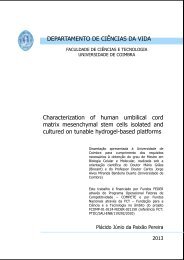Regulation of Apoptosis and Differentiation by p53 in Human ...
Regulation of Apoptosis and Differentiation by p53 in Human ...
Regulation of Apoptosis and Differentiation by p53 in Human ...
You also want an ePaper? Increase the reach of your titles
YUMPU automatically turns print PDFs into web optimized ePapers that Google loves.
CHAPTER 1: Introduction<br />
2007). Recently, iPs cells were generated from human adult dermal fibroblasts with the same 4<br />
factors mentioned above <strong>and</strong> from human fetal fibroblasts with Oct4, Sox2, Nanog, <strong>and</strong> LIN28 ,<br />
open<strong>in</strong>g the possibility <strong>of</strong> generat<strong>in</strong>g patient <strong>and</strong> disease-specific pluripotent stem cells<br />
(Takahashi et al., 2007; Yu et al., 2007).<br />
1.1.3- Culture methods for hESC propagation: advantages <strong>and</strong> limitations<br />
Two culture methods are widely used to propagate hESC (Figure 1.2): the orig<strong>in</strong>al technique<br />
used to culture the cells, referred to here<strong>in</strong> as the st<strong>and</strong>ard method <strong>and</strong> the serum-free method.<br />
The st<strong>and</strong>ard method <strong>of</strong> cultur<strong>in</strong>g hESC <strong>in</strong>volves weekly mechanical passag<strong>in</strong>g <strong>of</strong><br />
morphologically undifferentiated parts <strong>of</strong> a hESC colony onto full density (6x10 4 cell/cm 2 ) mouse<br />
or human fibroblast feeder (MEF <strong>and</strong> HEF, respectively) layers mitotically <strong>in</strong>activated <strong>in</strong> Dulbeco’s<br />
modified Eagle’s medium (DMEM) conta<strong>in</strong><strong>in</strong>g 20 % fetal calf serum (FCS) or human serum<br />
(Reub<strong>in</strong><strong>of</strong>f et al., 2000; Richards et al., 2002; Thomson et al., 1998). This protocol is dem<strong>and</strong><strong>in</strong>g<br />
<strong>in</strong> terms <strong>of</strong> time, money <strong>and</strong> effort, but has proven to be a safe <strong>and</strong> reliable method for the long<br />
term propagation <strong>of</strong> hESC. This is highlighted <strong>by</strong> the fact that hESC thus cultured have rarely<br />
been reported to develop genetic abnormalities dur<strong>in</strong>g culture. However, the major drawback <strong>of</strong><br />
this method is the low number <strong>of</strong> hESC available for experimentation. Some laboratories<br />
therefore opt to ma<strong>in</strong>ta<strong>in</strong> hESC stock cultures us<strong>in</strong>g this st<strong>and</strong>ard method <strong>and</strong> regularly establish<br />
fresh bulk cultures from these stocks for experimentation (Amit et al., 2000). The serum-free<br />
method <strong>of</strong> cultur<strong>in</strong>g hESC is performed accord<strong>in</strong>g to a protocol developed <strong>by</strong> Amit <strong>and</strong> colleagues<br />
which <strong>in</strong>volves passag<strong>in</strong>g <strong>of</strong> enzymatically (for example collagenase <strong>and</strong> tryps<strong>in</strong>) or nonenzymatically<br />
(cell dissociation solution, EDTA, etc) dissociated clumps <strong>of</strong> hESC on 1/3 density<br />
feeders (2x10 4 cell/cm 2 ) <strong>in</strong> DMEM/F12 supplemented with 20% Knockout serum replacement<br />
(KSR) from Invitrogen, <strong>and</strong> supplemented with fibroblast growth factor 2 (FGF-2). Despite the fact<br />
that KSR conta<strong>in</strong>s fewer components than FCS, its composition is still undef<strong>in</strong>ed <strong>and</strong> it conta<strong>in</strong>s a<br />
large amount <strong>of</strong> Albumax, a lipid-rich preparation <strong>of</strong> bov<strong>in</strong>e serum album<strong>in</strong> (BSA). This method<br />
allows for dramatic expansion <strong>of</strong> hESC. However, a number <strong>of</strong> reports have <strong>in</strong>dicated that this is<br />
accompanied <strong>by</strong> an <strong>in</strong>crease <strong>in</strong> genetic <strong>in</strong>stability, methylation changes <strong>and</strong> mitochondrial<br />
mutations, abnormalities also seen <strong>in</strong> cancer <strong>and</strong> hECC (Draper et al., 2004; Mitalipova et al.,<br />
2005; Brimble et al., 2004; Allegrucci et al., 2007). Allegrucci <strong>and</strong> colleagues exam<strong>in</strong>ed the DNA<br />
methylation pr<strong>of</strong>iles <strong>of</strong> more than 2000 genomic loci <strong>by</strong> restriction l<strong>and</strong>mark genome scann<strong>in</strong>g<br />
<strong>and</strong> showed that the culture conditions can <strong>in</strong>duce DNA methylation <strong>in</strong>stability <strong>in</strong> the hESC<br />
epigenome (Allegrucci et al., 2007). The unstable loci have been previously associated with a<br />
tumour phenotype. They also showed that the adaptation <strong>of</strong> the cell l<strong>in</strong>es to serum-free conditions<br />
result <strong>in</strong> additional epigenetic <strong>in</strong>stability (Allegrucci et al., 2007). This study highlights the<br />
importance <strong>of</strong> us<strong>in</strong>g appropriate techniques to analyze epigenetic changes <strong>and</strong> evaluate their<br />
consequences on hESC experimental utility <strong>and</strong> biosafety, as well the need for optimization <strong>of</strong><br />
derivation <strong>and</strong> culture protocols <strong>of</strong> hESC <strong>in</strong> order to m<strong>in</strong>imize culture-<strong>in</strong>duced <strong>in</strong>stability.<br />
In addition to optimized culture methods that prevent the occurrence <strong>of</strong> genetic <strong>in</strong>stability, novel<br />
technologies to purge abnormal hESC from large scale hESC cultures will have to be developed.<br />
- 7 -
















